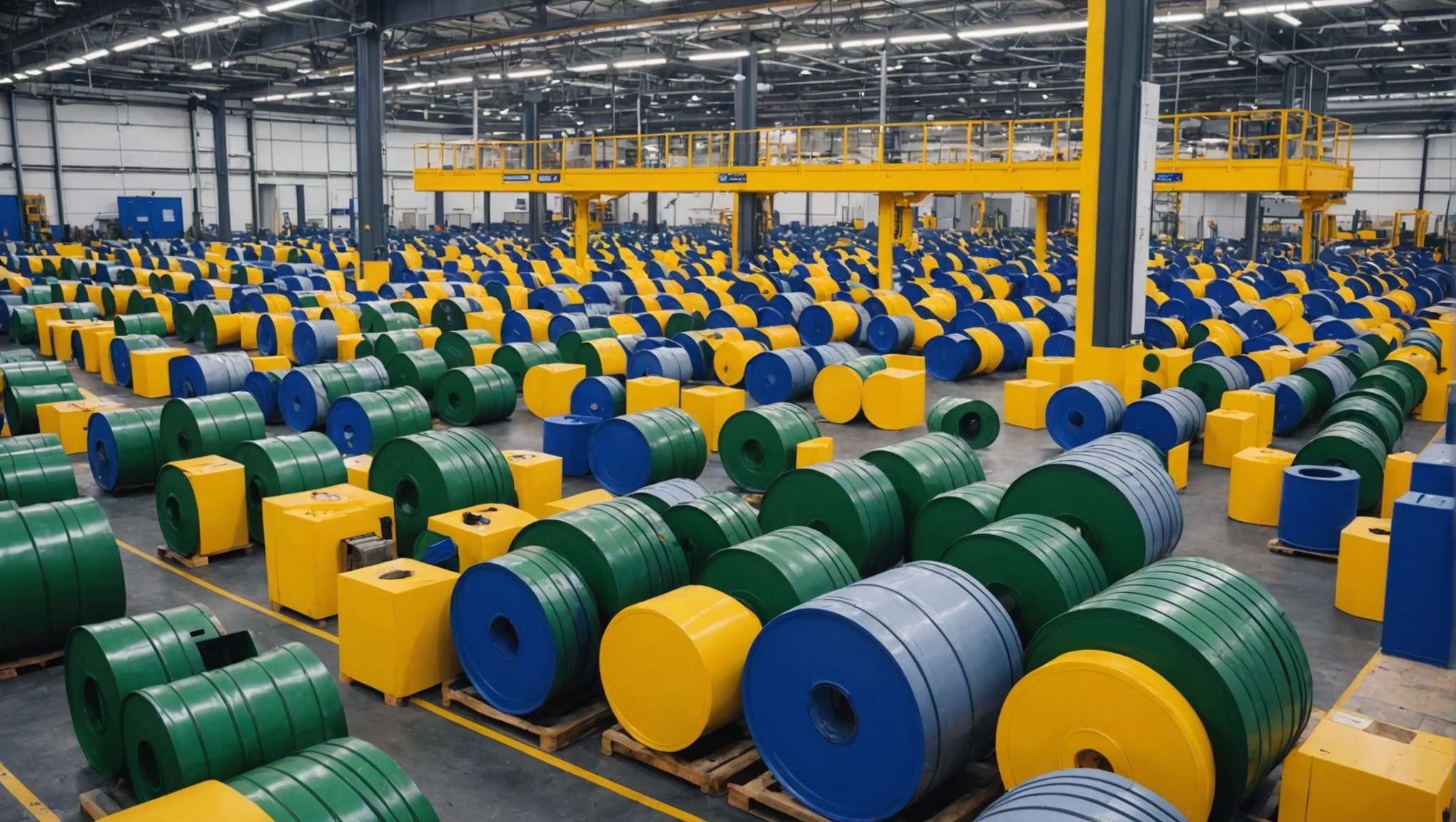Unlocking the Advantages: Embracing Circular Economy Practices in UK Manufacturing
As the world grapples with the challenges of climate change, resource depletion, and waste management, the concept of a circular economy has emerged as a beacon of hope for sustainable development. In the UK, manufacturing sectors are increasingly recognizing the benefits of adopting circular economy practices, which not only reduce environmental impact but also offer significant economic and social advantages.
Understanding the Circular Economy
The traditional linear economy follows a “take, make, dispose” model, where resources are extracted, used, and then discarded as waste. In contrast, a circular economy is designed to be restorative and regenerative by design. It aims to keep resources in use for as long as possible, extract the maximum value from them, and recover and regenerate materials at the end of their service life.
Also read : Top Strategies for Successfully Integrating AI in Financial Departments Across the UK
“Circular economy initiatives could reduce 40% of CO2 emissions from heavy industry,” notes a report by Sweco UK, highlighting the potential environmental benefits of such an approach.
Environmental Benefits
One of the most compelling reasons for embracing circular economy practices in manufacturing is the significant reduction in environmental impact. Here are some key ways in which a circular economy can benefit the environment:
Also to discover : Unlocking the Power of Predictive Analytics: A Guide to Elevating Demand Forecasting for UK Retailers
-
Reduced Waste and Emissions: By designing products and systems that are reusable and recyclable, manufacturers can drastically reduce the amount of waste generated. For instance, in the construction industry, cement recycling can save on raw materials and reduce the massive amounts of CO2 emissions associated with cement production. In 2022, global cement manufacturing produced 1.6 billion metric tonnes of CO2, accounting for about 8% of the world’s total emissions.
-
Resource Efficiency: A circular economy promotes the efficient use of resources. By reusing and recycling materials, manufacturers can reduce the demand on raw materials, thereby conserving natural resources. For example, the NHS in the UK throws away 133,000 tonnes of plastic each year, but through circular approaches, much of this waste can be reused or recycled, reducing the environmental impact.
-
Closed-Loop Systems: Circular economy practices involve creating closed-loop systems where materials are consistently reused and repurposed. This approach extends the lifespan of materials and reduces the need for new raw materials. In the medical technology sector, reusing medical devices can lead to an average decarbonisation of 38% to 56% compared to single-use devices.
Economic Benefits
Adopting circular economy practices is not just environmentally beneficial; it also offers several economic advantages:
-
Cost Savings: By reducing waste and the need for raw materials, businesses can save significantly on production costs. For example, in the construction sector, recycling cement can lower material and disposal costs, leading to long-term savings. Additionally, companies that adopt circular practices can benefit from lower landfill costs and reduced carbon prices, which are projected to reach €100 per tonne of CO2 in the European Union by 2030.
-
Job Creation and Economic Growth: A circular economy can stimulate economic growth by creating new job opportunities and boosting local industries. The Design for Life programme in the UK aims to create skilled jobs and growth opportunities in supporting industries such as decontamination and materials recovery. According to WRAP, an economy-wide shift to a circular economy could bring £75 billion to the economy and create 500,000 new jobs by 2030.
-
Competitive Advantage: Businesses that invest in circular economy practices can position themselves as leaders in sustainability, which can lead to securing more contracts and improving their market reputation. As clients and governments increasingly prioritize eco-friendly practices, companies that adopt circular economy models will have a competitive edge in the market.
Practical Implementation
Implementing circular economy practices in manufacturing requires a multifaceted approach. Here are some key strategies and examples:
Collaborative Effort
Creating circular solutions often requires a collaborative effort between various stakeholders, including clients, developers, and contractors.
-
Client Responsibility: Clients should set out clear policies for circular opportunities, steering developments towards sustainable practices. For instance, in the construction sector, clients can work with developers to identify materials that can be directly reused or recycled.
-
Material Audits: Demolition contractors should conduct thorough audits of materials in developments to identify opportunities for reuse and recycling. This involves working closely with design teams to ensure that materials are used efficiently.
Digital Technologies
Digital technologies play a crucial role in enabling circular economy practices by enhancing resource efficiency and reducing waste.
-
Real-Time Data: Using real-time data and analytics can help manufacturers optimize production planning, inventory management, and supply chain operations. For example, machine learning algorithms can predict demand and adjust production accordingly, reducing waste and excess inventory.
-
Servitization: Digital technologies can also enable servitization, where companies focus on providing services rather than just products. This approach encourages the reuse and recycling of products, extending their lifespan and reducing waste.
Closed-Loop Production
Closed-loop production systems are essential for a circular economy, where materials are continuously cycled back into production.
-
Recycling and Upcycling: Manufacturers should design products that can be easily recycled or upcycled. For instance, in the construction industry, recycled concrete can be used to create new building materials, reducing the need for raw materials.
-
Product Design: Products should be designed with sustainability in mind. This includes designing for disassembly, reuse, and recycling. Companies like Sweco UK are helping set the standard for ‘reuse and recycle’ in construction projects, such as the One Exchange Square in London.
Case Studies and Examples
Several initiatives and projects in the UK demonstrate the successful implementation of circular economy practices in manufacturing.
New £5.5 Million Manufacturing Centre
A new £5.5 million manufacturing centre in the UK aims to bring critical circular economy practices to the forefront of manufacturing. This centre will focus on reducing waste, cutting emissions, and creating sustainable products. By adopting circular economy practices, the centre expects to make a significant impact on the UK’s net-zero ambitions and drive economic growth.
Design for Life Programme
The Design for Life programme is an initiative by the UK’s medical technologies and innovation directorate to adopt a circular approach to medical technologies. This programme involves designing, procuring, and processing medical products in a way that enables them to be reused, remanufactured, or recycled. The programme has already shown promising results, with significant reductions in waste and emissions, and improved resilience in supply chains.
Challenges and Solutions
While the benefits of a circular economy are clear, there are several challenges that businesses face when implementing these practices.
Initial Investment
One of the most significant challenges is the substantial initial investment required for implementing recycling technologies and infrastructure. However, as innovative technologies emerge and government incentives for sustainable practices increase, these initial expenses are becoming more manageable. Ibon Iribar, Investment and Open Innovation Advisor at Cemex Ventures, emphasizes that “these initial expenses are dropping quickly as innovative technologies continue to emerge, and government incentives for sustainable practices increase”.
Behavioral Change
Adopting a circular economy requires a shift in mindset and behavior across the entire supply chain. This involves educating stakeholders about the benefits of circular practices and encouraging collaboration. For example, the UKGBC Circular Economy Report highlights the need for a holistic approach, viewing circular economy as a business strategy rather than just a sustainability initiative.
Embracing circular economy practices in UK manufacturing is not just a trend; it is a fundamental shift in the way the industry operates. With its potential to reduce environmental impact, create economic benefits, and drive sustainable growth, the circular economy is an essential strategy for the future.
Here is a detailed bullet point list summarizing the key advantages and strategies for implementing circular economy practices:
-
Environmental Benefits:
-
Reduce waste and emissions
-
Promote resource efficiency
-
Create closed-loop systems
-
Extend the lifespan of materials
-
Economic Benefits:
-
Cost savings through reduced waste and raw material use
-
Job creation and economic growth
-
Competitive advantage in the market
-
Practical Implementation:
-
Collaborative effort between stakeholders
-
Use of digital technologies for real-time data and servitization
-
Closed-loop production systems
-
Sustainable product design
-
Case Studies and Examples:
-
New £5.5 million manufacturing centre
-
Design for Life programme in medical technologies
-
Challenges and Solutions:
-
Managing initial investment costs
-
Encouraging behavioral change across the supply chain
As we move forward, it is clear that the return on investment for these efforts will far outweigh the initial costs. Businesses that invest in circular economy practices now will not only benefit from lower material and disposal costs but also position themselves as leaders in sustainability, securing a competitive edge in the market.
Table: Economic and Environmental Impact of Circular Economy Practices
| Aspect | Circular Economy Impact | Traditional Linear Economy |
|---|---|---|
| CO2 Emissions | Reduce by up to 40% in heavy industry | Increase by up to 23% over the next two decades |
| Waste Reduction | Reduce waste by reusing and recycling materials | Generate significant amounts of waste, with over 35% of construction waste ending up in landfills |
| Cost Savings | Lower material and disposal costs, potential savings of €210 billion by 2050 | Higher costs due to raw material extraction and waste disposal |
| Job Creation | Create 500,000 new jobs by 2030 through an economy-wide shift | Limited job creation in traditional linear economy |
| Economic Growth | Boost UK GDP by an additional 0.5% by 2030 and create roughly 700,000 jobs in Europe | Limited economic growth due to resource depletion and waste management costs |
| Resource Efficiency | Promote efficient use of resources, reducing the demand on raw materials | Inefficient use of resources, leading to resource depletion |
In the words of Ibon Iribar, “Cement recycling is more than just a trend; it’s a fundamental shift in the way the industry operates.” This sentiment applies broadly to all sectors embracing circular economy practices. As we navigate the complexities of sustainable development, it is clear that a circular economy is not just a necessity but a transformative opportunity for UK manufacturing.






